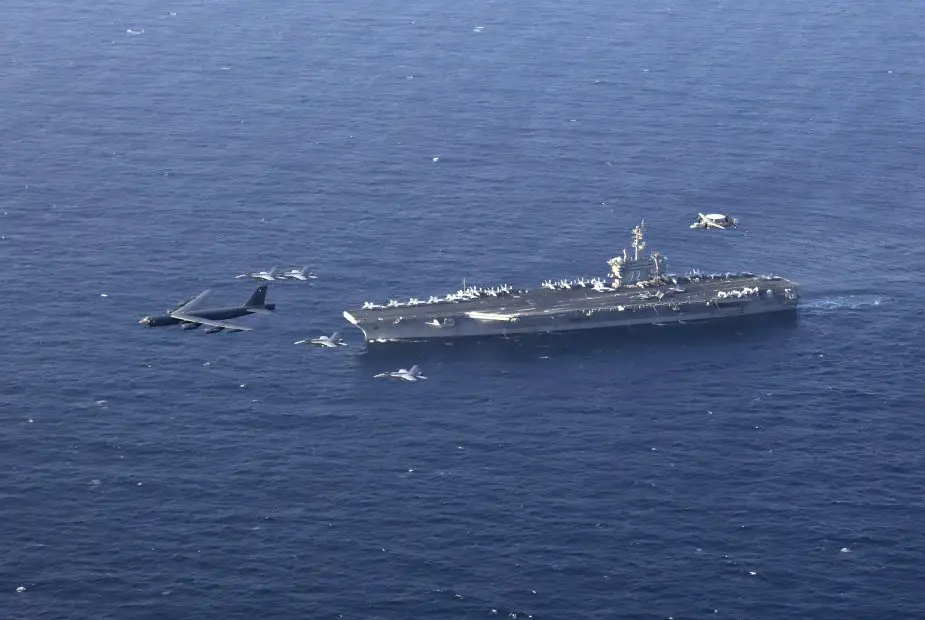Breaking news
USS Abraham Lincoln participates in joint exercise with U.S. Air Force.
On June 1, Carrier Air Wing (CVW) 7, attached to the Abraham Lincoln Carrier Strike Group (ABECSG), and A U.S. Air Force B-52H Stratofortress, part of a Bomber Task Force assigned to the 20th Expeditionary Bomb Squadron, conducted joint operations in the U.S. Central Command area of responsibility.
 The Abraham Lincoln Carrier Strike Group and a U.S. Air Force B-52H Stratofortress assigned to the 20th Expeditionary Bomb Squadron, and part of the Bomber Task Force deployed to the region, conduct joint exercises in the U.S. Central Command area of responsibility (Picture Source: U.S. Navy photo by Mass Communication Specialist 1st Class Brian M. Wilbur)
The Abraham Lincoln Carrier Strike Group and a U.S. Air Force B-52H Stratofortress assigned to the 20th Expeditionary Bomb Squadron, and part of the Bomber Task Force deployed to the region, conduct joint exercises in the U.S. Central Command area of responsibility (Picture Source: U.S. Navy photo by Mass Communication Specialist 1st Class Brian M. Wilbur)
“It's a pretty awesome feeling to look up and see our jets flying alongside the Air Force bomber,” said Capt. William "Spig" Reed, commander, CVW- 7. "The training the air wing conducted with the B-52's today is an incredible demonstration of how our military can to rapidly join capabilities to enhance our lethality and our ability to respond to any threat when called upon."
During the exercises, CVW-7 and the 20th Expeditionary Bomb Squadron conducted several joint training evolutions designed to improve operational tactics in several warfare areas. Exercises included air-to-air training, flying in formation, and simulated strike operations in defence of a national asset.
“While the Air Force trains different assets together all the time, including Navy F-18s, we typically don’t have the opportunity to integrate with the surface fleet,” said Lt. Col. Scott Mills, U.S. Air Forces Central Command 609th Air and Space Operations Center air and space strategist. “As we train together, it gives us the chance to examine the bias we each bring to the engagement. We each learn about the other’s domain by searching for areas of dissonance.”
F/A-18E Super Hornets and E-2D Growlers from CVW-7, embarked on the Nimitz-class aircraft carrier USS Abraham Lincoln (CVN 72), conducted a self-escort strike with an Air Force B-52H Stratofortress Bomber. With the Lincoln aircraft simulating opposing and friendly forces, the training gave both sides the chance to interact with elite aircraft.
“The most interesting part about working with any individual aircraft you haven’t had the chance to work with yet is getting to see what unique capabilities it has,” said Lt. Chase Strickland, a pilot attached to the “Sidewinders” of Strike Fighter Squadron (VFA) 86 and CVW-7’s coordination lead of the joint exercise. “It’s fascinating getting to train and work with the strategic bomber that has updated capabilities, the latest electronics and the most advanced software.”
The B-52H Stratofortress is a long-range, subsonic, jet-powered strategic bomber that has been operated by the U.S. Air Force since 1955. The aircraft can carry up to 70,000 pounds of weapons and has a typical combat range of more than 8,800 miles. Its anti-ship and mine-laying capabilities make it a highly-effective asset to assist the Navy in ocean surveillance.
“Each of our respective services influences the other,” Mills said. “Future conflicts will almost never be restricted to a single domain, and even then the other service can enhance the effectiveness of the others. Today’s mission represents our ability to project air and sea power around the globe. When we act, we do so as one force, no separate services. Exercises like today ensure that can happen anywhere, anytime.”
CVW-7 Super Hornets conducted a joint close air support exercise with the Bomber. Additionally, MH-60R Sea Hawk helicopters from CVW-7, along with the B-52H, conducted strike coordination and reconnaissance (SCAR) exercises. The exercise provided a rare training opportunity as it joined multiple tactical aircraft across DoD lines.
“The training shows effective coordination between two of the strongest military components as they come together to execute a single mission set,” Strickland said. “It illustrates the effective leadership and the team-of-teams capability within the DoD.”
The demonstration of flexible and adaptable joint operations shows U.S. military forces are prepared to respond to contingencies and defend U.S. forces and interests in the region.
“This operation allowed us to train interoperability, focus on defense and interdiction, and provide air support to our naval fleet defense,” said Lt. Gen. Joseph Guastella, Combined Forces Air Component Commander. “Our land, air, and sea assets are even stronger and more effective together and we’re postured to face any threats toward U.S. forces in the region.”
ABECSG is deployed to the U.S. 5th Fleet area of operations in support of naval operations to ensure maritime stability and security in the Central Region, connecting the Mediterranean and the Pacific through the western Indian Ocean and three strategic choke points. With Abraham Lincoln as the flagship, deployed strike group assets include staffs, ships and aircraft of Carrier Strike Group 12 (CSG 12), Destroyer Squadron 2 (DESRON 2), USS Leyte Gulf (CG 55) and Carrier Air Wing 7 (CVW 7).


























